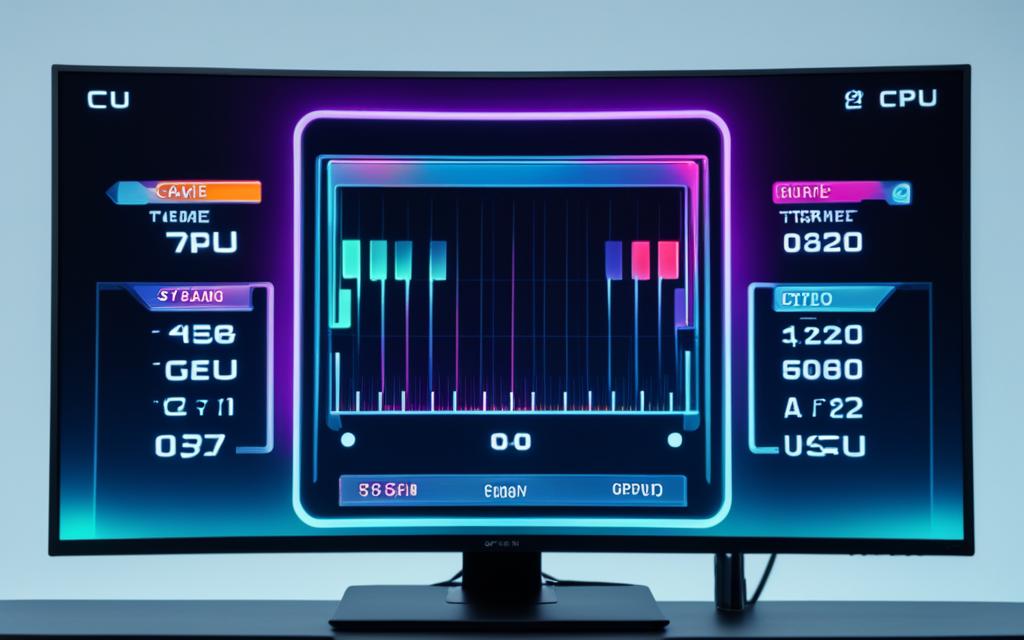Table of Contents
Understanding CPU temperature monitoring is key for better gaming performance. An overheating CPU can make your game lag or crash. It ruins the fun and can damage your hardware over time. Monitoring the CPU’s temperature in real-time helps. This way, you can avoid overheating and make sure your game runs smoothly.
Setting up a good monitoring system can make your games more enjoyable. You won’t be interrupted by technical issues. It’s important to know that CPUs should stay between 40–65°C (104–149°F) when you’re not gaming. While gaming, the temperature might rise to about 70–80°C (158–176°F)12. So, keeping an eye on these temperatures is crucial.
Key Takeaways
- Monitoring CPU temperature is essential for optimal gaming performance.
- Excessive heat can lead to significant hardware damage and reduced stability.
- Regular monitoring enables users to maintain CPU temperatures within safe limits.
- Utilising temperature tools can significantly enhance your gaming experience.
- The ideal CPU temperature during intensive tasks is between 70-80°C.
Understanding the Importance of CPU Temperature Monitoring
Keeping the CPU at the right temperature is crucial for good performance and stability. When used heavily, like in gaming or editing videos, CPUs can get very hot. This can lead to overheating. Overheating isn’t just a minor annoyance; it can seriously harm your computer’s parts over time. So, it’s vital to regularly check how hot your CPU is.
Impact on Performance and Stability
High CPU temperatures can make your computer less stable. If it gets too hot, the CPU might lower its power to avoid damage. This can cause your computer to shut down suddenly, become slow, or not work as well. Usually, CPUs are between 30°C to 40°C when not doing much. They can jump to 60°C to 85°C under heavy use. That’s why it’s important to keep an eye on temperatures, especially when doing tasks that require a lot of power3.
Good temperature control means your computer can keep running smoothly, even when you’re playing intense games or using demanding software.
Long-Term Hardware Health
The health of your computer over time depends a lot on how well you manage its temperature. Regular high temperatures might mean your cooling system needs an upgrade4. To help keep things cool, it’s a good idea to clean out dust often. This can lower the CPU temperature and help your computer last longer. Putting thermal paste between the CPU and its cooler helps spread out the heat5.
By paying attention to temperature changes, you can deal with heating issues early. This protects your investment in your computer hardware.
What Are Normal CPU Temperature Ranges?
Knowing normal CPU temperature ranges is key for great performance. This is especially true for gamers and content creators. CPUs usually sit between 30°C and 50°C when not doing much. Ideally, they should be between 30°C to 40°C for light tasks67. On the other hand, heavy use like gaming or video editing can push temps to 70°C to 80°C. Being aware of these limits helps keep your CPU running well and lasting longer.
Idle vs Load Temperatures
The ideal idle temperature range is between 30°C to 40°C. This range helps the processor work effectively without any extra pressure6. When doing intense tasks, the load temperature range may hit 60°C to 80°C. This is still okay for most new CPUs7. Yet, if temperatures keep above 80°C, it might mean something is wrong.
Manufacturer Specifications for Different CPUs
Every CPU has its own temperature guidelines. For example, AMD’s Ryzen 5000 series can go up to 95°C. Intel’s top-end i9 models can reach up to 100°C7. It’s crucial to know these CPU specifications to stay within safe temperature limits. This matters a lot during long gaming moments when temps naturally go up.
How to Check Your Computer’s CPU Temperature
It’s important to know how to check your CPU’s temperature to keep it running well. You can do this through your computer’s BIOS/UEFI settings or by using special software. Both ways have their benefits, depending on what you prefer.
Using Built-in BIOS/UEFI Tools
To use BIOS or UEFI, restart your computer and press a certain key. This could be F2 for brands like Acer, Dell, and Asus or Del for MSI. Inside, you’ll see the CPU’s temperature but only when your computer is not doing much.
This method gives you a quick look at the temperature. However, it’s mainly useful when the computer is not being used heavily. It won’t show how the temperature changes with more intense tasks.
Third-Party Software Options
If you want more detailed tracking, consider using third-party software. Tools like Core Temp and NZXT CAM let you watch temperature changes as they happen. They even warn you if things get too hot, which is especially handy for gamers.
Core Temp is free and works with many versions of Windows. NZXT CAM has additional features for keeping an eye on things8. HWiNFO and SpeedFan are also good choices. They offer more in-depth views into how your CPU is doing9.
Recommended Tools for Monitoring CPU Temperature
Finding good tools for keeping an eye on CPU temperature is key. This is crucial during intense gaming. Core Temp stands out due to its easy installation and powerful Core Temp features. It shows core temperature readings live on the Windows taskbar. It’s perfect for gamers who want to monitor their CPU’s health without stopping the game.
Core Temp: Installation and Features
NZXT CAM is another great option, known for its easy-to-use interface and in-game overlay feature. It lets players keep track of temperatures without leaving their game. HWInfo is ideal for advanced users, providing detailed system info. SpeedFan, on the other hand, lets you check temperatures and control fan speeds. It’s useful for those who want to tweak their cooling system.
NZXT CAM for Enhanced Monitoring
Using these tools helps make sure your CPU stays at safe temperatures. Regular checks can improve both longevity and performance. This protects against overheating, a risk for even the strongest systems. By monitoring regularly, as suggested here, you can keep your gaming setup in top shape. Whether it’s optimising fan settings or keeping your rig dust-free, these tools help maintain high performance1071. in your gaming adventures.
FAQ
Why is monitoring CPU temperature important while gaming?
It’s crucial to keep an eye on your CPU temperature as it affects gaming quality and system reliability. Heat build-up can make the CPU slow down or even stop, leading to game lags or shutdowns. By checking temperatures often, you protect your device and enjoy smoother gaming.
What are the normal CPU temperature ranges during gaming?
When not being used much, CPU temperatures hover around 40-65°C (104-149°F). With heavy use, like gaming, they can jump to 70-80°C (158-176°F). If the temperature often goes over 80°C (176°F), your system might be overheating, so it’s best to sort it out quickly.
How can I check my CPU temperature?
For a quick temperature check, peek into your BIOS/UEFI where real-time data is shown. Yet, for constant monitoring, especially when playing games, try software like Core Temp, NZXT CAM, or HWiNFO. They observe temperature changes and warn you if it gets too hot.
What are the recommended tools for monitoring CPU temperature?
Core Temp gets you straight to the point with live core temperature readings. NZXT CAM combines ease of use with handy in-game overlays. For those who enjoy details, HWiNFO offers in-depth system info. SpeedFan also tweaks fan speeds besides temperature checks, meeting various users’ needs.
How can high CPU temperatures impact gaming performance?
Too much heat can slow down the CPU, causing games to stutter or crash. This overheating can harm your components over time, shortening their life. Regular temperature monitoring ensures games run smoothly without straining the system.
Source Links
- https://www.avast.com/c-how-to-check-cpu-temperature – How to Check and Monitor Your CPU Temperature
- https://www.electronicshub.org/monitor-cpu-temp-and-gpu-temp-while-gaming/ – How to Monitor CPU and GPU Temp While Gaming?
- https://us.vaio.com/blogs/innovation-hub/how-to-monitor-your-cpu-temperature – How To Monitor Your CPU Temperature
- https://pcinternational.co.za/how-to-monitor-cpu-temperature/ – Effective Guide on How to Monitor CPU Temperature
- https://koolingmonster.com/insights/how-to-check-cpu-temperature-and-why-is-it-important – How to Check CPU Temperature and Why Is It Important? — Kooling Monster
- https://www.noyafa.com/blogs/knowledge-base/good-cpu-temperature – What Is A Good CPU Temperature? A Guide to Keep Your Processor Cool
- https://www.tomshardware.com/how-to/how-to-check-cpu-temp-temperature – How to Check Your CPU Temperature
- https://www.avg.com/en/signal/check-cpu-temperature – How to Check and Monitor CPU Temperature on Windows and Mac
- https://www.wikihow.com/Monitor-CPU-Temperature – How to Monitor Your CPU Temperature: 4 Easy Tools
- https://www.pcmag.com/how-to/how-to-monitor-your-cpu-temperature – cpu temperature monitor








